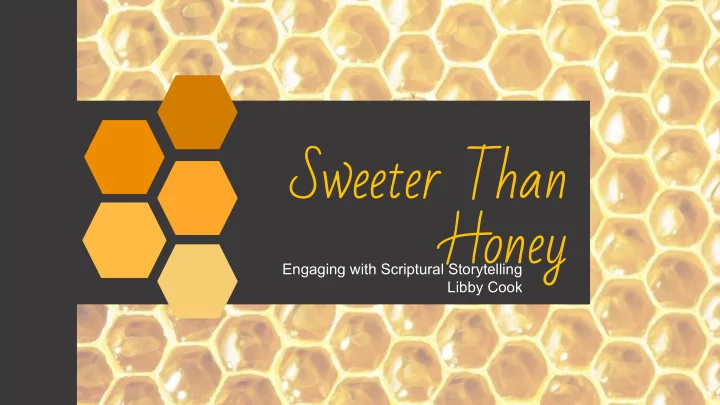

Sweeter Than Honey Engaging with Scriptural Storytelling Libby Cook
Learning Intents: • We are learning what story telling is and who ‘designed’ the process. • We are learning how to tell a story in our own context and about the wondering process. • We are learning how to set up and resource for storytelling.
What is storytelling? • “Storytelling is an ancient , spiritual and everlasting ritual that has the ability to help people to “find their way through the dark woods and briar patches to new freedom and well-being.” Nancy Mellot • Story can make the link between the sacred inner world of the child which holds feeling, emotion, creativity and imagination to the outer world that they must enter.
Two Fundamental Approaches to Storytelling
Catechesis of the Good Shepherd Godly Play • Sofia Cavalletti &Gianna Gobbi (1954) • Jerome Berryman • Montessori Based • Montessori Based • Play and reflection are key • Play and reflection are key • Works to have children fall in love with • Allows children to be immersed in the God by themselves. scripture and religious language to • The scriptural focus is on the parables as identify themselves as in connection with well as Scriptures associated with the God. liturgical year and the sacraments. • Based around sacred spiritual objects • Uses 2D and 3D figures and other and characters. objects to tell stories • Once the process is known any biblical • Christocentric story can be told. • Presents God as the Good Shepherd. • Uses 2D and 3D figures and other objects to tell stories • Theocentric • Presents God as creator.
Catechesis of the Good Shepherd The Process 1. Begin by narrating the content of the story in your own words, but staying as close to the Biblical text as possible. 2. A time of listening and reflecting. 3. Read the biblical text solemnly, usually from the Scripture booklet. 4. Present the materials. 5. Move the materials (objects and figures according to the sequence of the parable). 6. Return the material to where it is kept. 7. Invite children to respond to the story in art. 8. Invite the children to play with the material- only the material they have already experienced in sessions .
Godly Play- The Process Entering the Space and Building the Circle • Children should know that they enter the circle quietly and reverently. The storyteller is sitting in the circle. Building the Circle: • The storyteller helps to build the circle, making sure that the needs of all children are met. Presentation: • The storyteller begins by saying, “Watch where I go to the get this story as you might like to play with it later.” • The session will come from the gold parable boxes, the sacred story shelves or liturgical shelves. • During the story, the storyteller keeps his or her eyes on the materials, not on the children. Wondering: • At the presentation’s end, the storyteller invites the children to wonder about the story. • At the end of the wondering, the storyteller reverently packs up the material and puts it away. Response: • Children are invited to respond to the story using art/craft materials provided.
Scriptural Storytelling- My Process • My storytelling is based more on the structures of Godly Play. • I use 2D materials to tell stories and 3D materials to show real biblical events. • Parables are kept in gold boxes as they are ‘Gifts from God’ and are special stories told by Jesus. • Other stories are kept in brown boxes ( or boxes of a different colour). • Students are seated in a semi circle during the telling of the story. • I learn the script using the scripts from CEO Sydney accessible via RE Online or from CEO Ballarat. If necessary I will write my own using a children’s bible for reference. • When telling the story I do not look at the students so as to keep the focus solely on the story. • After the story I ask a series of ‘wondering’ questions. All answers are accepted neutrally before inviting students to take part in the reflective wondering time.
The Story of Noah Script with permission from CEO Sydney
Any wonderings?
Wondering in Year 2- Classroom Setup
Wondering in Year 2- The Story of Noah
Setting up Scriptural Storytelling in your school. Scripts • DBB schools have permission from Sydney CEO and Ballarat to use their scripts. https://reonline.sydcatholicschools. nsw.edu.au/ http://www.ceoballarat.catholic.edu .au/learning-teaching/religious-edu cation/godly-play/ • Scripts can be created yourself – using child friendly language.
Setting up Scriptural Storytelling in your school. Resources • Some 2D figures can be printed from Sydney RE Online https://reonline.sydcatholicschools.nsw.edu.au/ http://www.ceoballarat.catholic.edu.au/learning-teaching/religious-education/godly-play/ Think about: • Individual kits or a range of pieces that can be put together to make kits? • Make your own or buy? • Parents as resources.
Recommend
More recommend